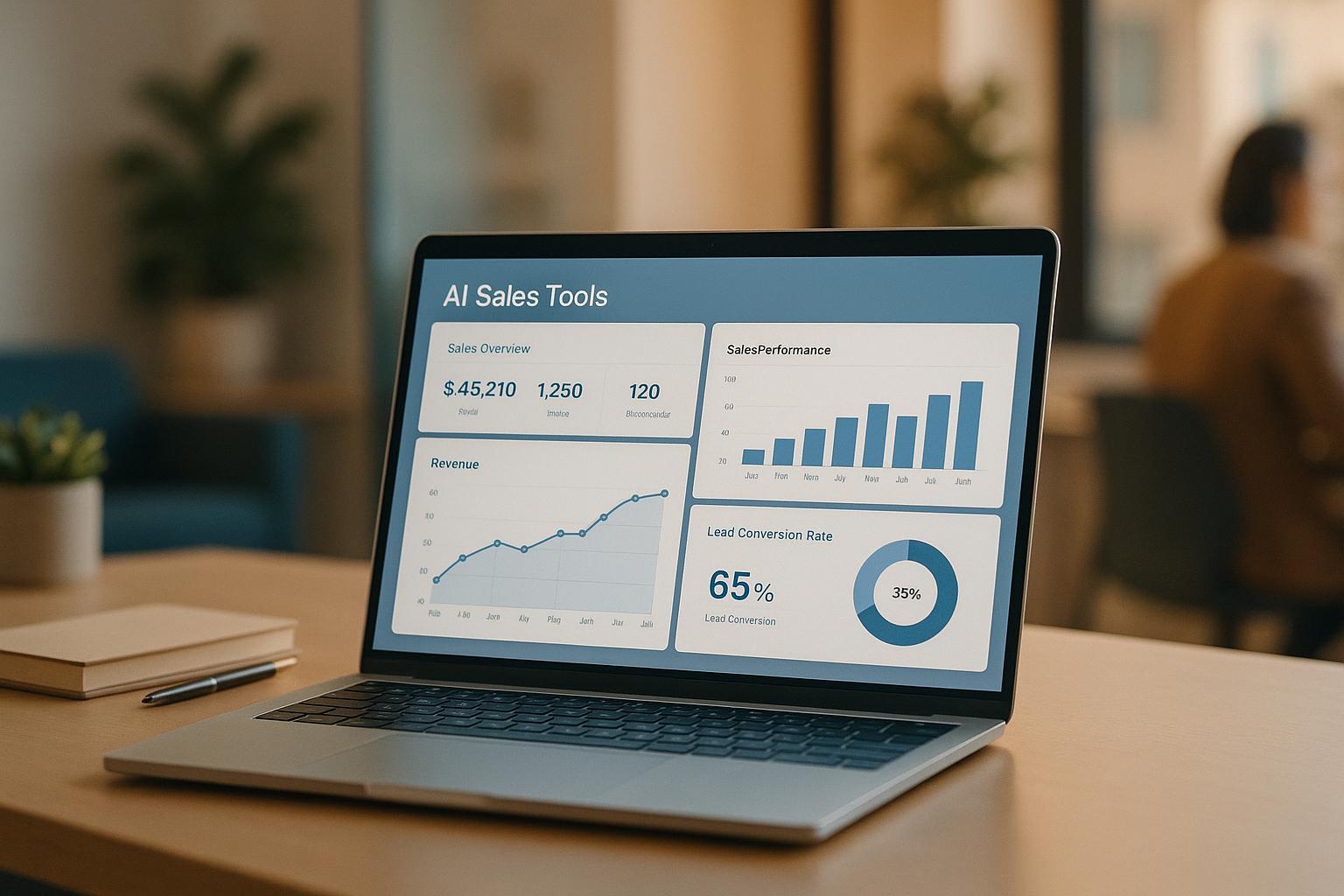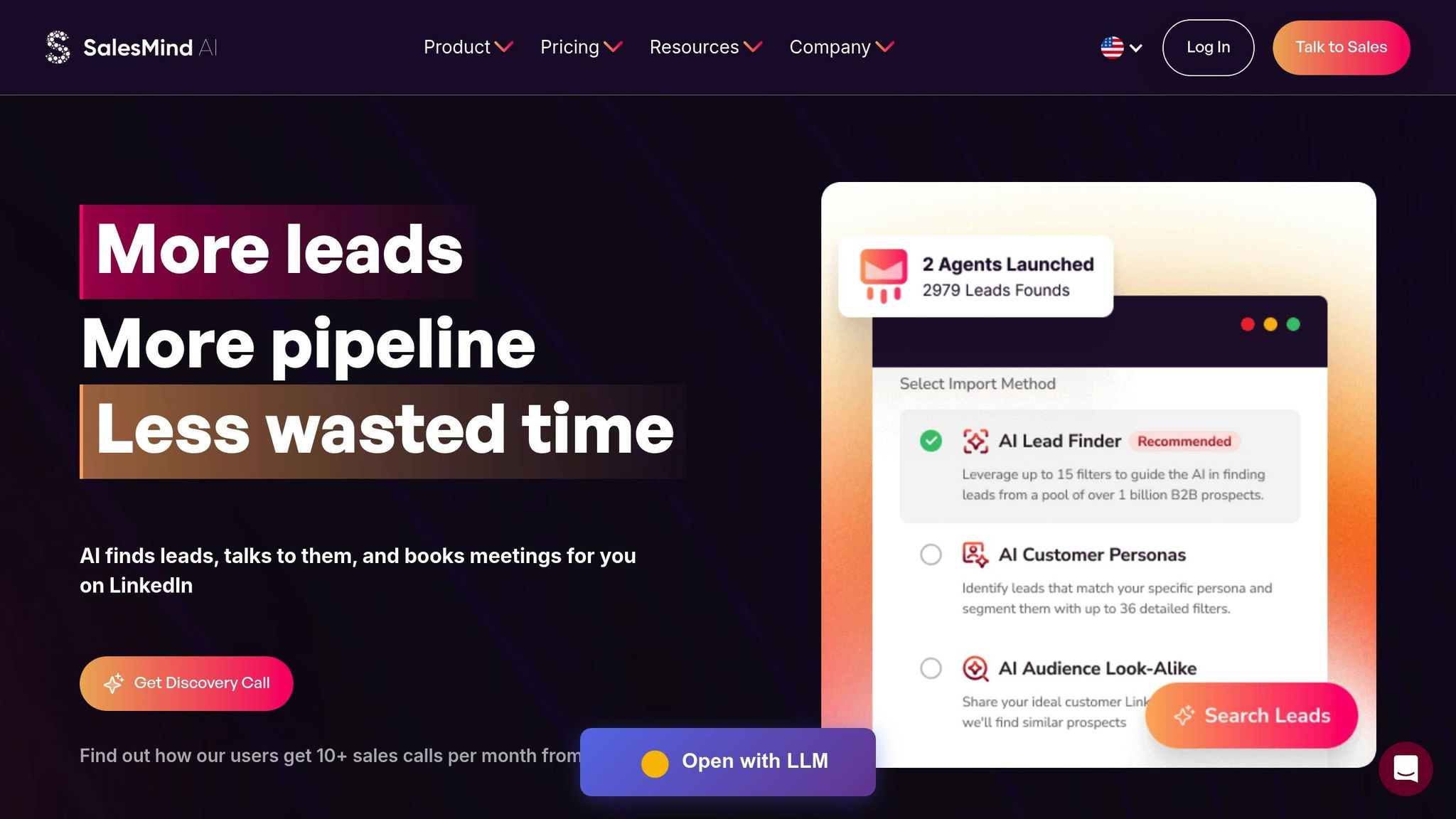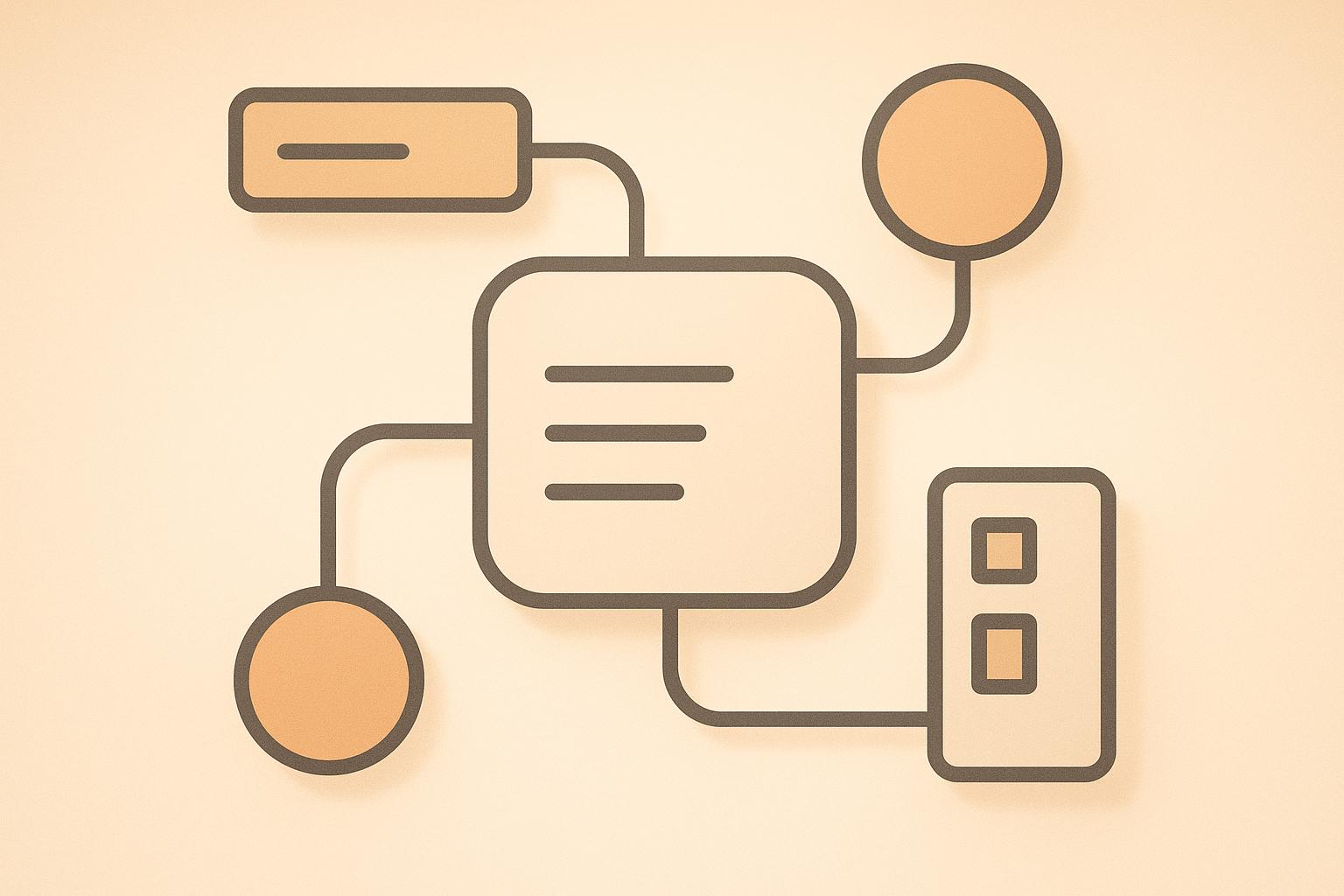
.avif)
Julien Gadea
Julien Gadea specializes in AI prospecting solutions for business growth. Empowering businesses to connect with their audience with SalesMind AI tools that automate your sales funnel, starting from lead generation.
Finding the right AI sales tool can transform your sales process, but the key is matching the tool’s features to your specific goals. Whether you’re focused on LinkedIn outreach, multichannel automation, or deal management, each tool offers unique strengths. Here’s a quick breakdown:
- SalesMind AI: Best for LinkedIn prospecting with automated messaging and lead scoring.
- Tool B: Ideal for multichannel outreach and predictive scoring, suited for large enterprises.
- Tool C: Focuses on real-time deal insights and intent signals for faster deal closures.
- Tool D: Streamlines LinkedIn outreach with AI-driven personalization and follow-ups.
Each tool addresses different sales challenges. Choose based on your team’s goals - whether it’s generating leads, improving conversions, or managing deals more effectively. Start small with a pilot program to gauge impact and ensure the tool integrates smoothly into your workflow.
13 Best AI Sales Tools & Agents 2025 (Ranking & Full Demo)
1. SalesMind AI

SalesMind AI is a LinkedIn outreach automation tool designed for B2B prospecting. It focuses on streamlining personalized messaging and lead qualification directly within LinkedIn, making it a go-to solution for businesses that rely heavily on LinkedIn as a primary sales channel.
Lead Generation Features
SalesMind AI's lead generation tools are built around precise prospect targeting and automated engagement workflows. Users can set specific filters to define their ideal audience, ensuring outreach efforts are directed at prospects with higher chances of conversion. The platform claims to identify "only the best leads", saving sales teams from wasting time on low-value prospects.
It automates LinkedIn prospecting by initiating follow-up messages until a reply is received, allowing users to reach hundreds of potential leads effortlessly. This feature tackles a common challenge for sales teams - keeping up with follow-ups across extensive prospect lists.
Alex L., CTO at Slash Co, shared, "SalesMind AI boosted my productivity in lead prospecting by 10× from the very first week. At full capacity, the AI managed to get 5 to 10 new conversations started per week, opening doors to valuable connections I might not have reached otherwise" [5].
Sales Automation Capabilities
The platform automates connection requests and personalized messages by pulling data from prospect profiles and websites. This ensures that outreach messages are both relevant and tailored, solving the issue of creating personalized communication at scale.
SalesMind AI also features an AI-powered unified inbox that consolidates all LinkedIn interactions into a single interface. This includes options for instant replies, tagging, and reminders, simplifying the management of multiple conversations without the need to switch between tools.
Henry F., an Enterprise Account Executive at Salesforce, noted, "SalesMind AI automated tasks that would have taken me days or weeks of consistent manual work." After just 8 days of using the free trial, he reported receiving "4-5 responses per day" and praised the AI-recommended messaging that utilized information from his website and other sources [5].
These automation tools integrate smoothly into existing workflows, paving the way for CRM and interface integration, which is explored further in the next section.
Integration Flexibility
Though primarily focused on LinkedIn, SalesMind AI offers CRM integration to ensure that prospect data is seamlessly incorporated into existing sales processes. The platform provides a master dashboard where users can track lead interactions, monitor sequences, and view real-time progress for individuals and teams alike.
Additionally, its Chrome extension connects directly with LinkedIn, allowing users to manage prospecting activities without leaving the platform. This integration keeps workflows uninterrupted while delivering the benefits of automation.
ROI and Business Impact
Users have reported significant productivity improvements and scalable lead generation with SalesMind AI. Steven Huibers, COO of Policereports.ai, shared that the tool delivered "3x the results compared to other LinkedIn outbound tools" he had tried [5]. The platform enjoys high user ratings, including 4.7 on G2, 4.4 on Trustpilot, and 5 on the Chrome Store [5].
Beyond increasing lead volume, the platform enhances lead quality. Sébastien D., a Freelance professional in Information Services, explained, "By automating all conversations and personalizing them with direct insights extracted from my prospect profiles, it gives accurate and high-quality outputs that helped me get more prospect meetings and thus close more deals" [5].
"SalesMind AI has transformed our lead generation process. The platform's intuitive interface and smart automation features have significantly boosted our sales efficiency. The lead scoring system is particularly impressive, providing clear insights into lead quality." - Svit Babarovic, Food and Beverage Retail, MountainDrop [5]
One standout feature is the advanced lead scoring system, which helps sales teams focus on high-priority prospects. This is especially useful for businesses managing extensive prospect databases, where manual lead qualification is time-consuming and inefficient.
2. Tool B
Tool B stands out with its multichannel automation and predictive scoring features. Unlike tools that focus solely on LinkedIn, Tool B integrates seamlessly across email, social media, and phone channels. This makes it a great fit for sales teams looking to connect with prospects through multiple touchpoints, setting it apart from LinkedIn-centric platforms.
Lead Generation Features
Tool B’s lead generation capabilities are built around predictive scoring and the ability to train custom GPT models using your company’s proprietary data. This allows businesses to craft highly tailored outreach campaigns that reflect their unique messaging and industry insights. The predictive scoring feature identifies high-value leads by analyzing prospect behavior and engagement patterns. According to user reports, this has led to conversion rate improvements of up to 25% in several case studies.
The platform serves both B2B and B2C sales teams effectively. For B2B, it focuses on factors like company size, industry, and identifying key decision-makers. For B2C, it prioritizes behavioral triggers and purchase intent signals, ensuring campaigns are targeted and relevant.
Sales Automation Capabilities
Tool B takes automation a step further by including voice-based AI commands and mobile-friendly functionality. Sales reps can use voice commands to launch campaigns, update CRM records, and manage follow-ups - an especially useful feature for field teams and remote workers.
The platform automates the entire sales process, from initial outreach to follow-up nurturing, while also handling CRM updates. This eliminates the need for manual data entry, saving time and reducing errors. In a 2024 survey of sales teams using AI tools, 78% reported higher productivity after adopting Tool B’s automation features. The system also coordinates multichannel sequences effortlessly. For instance, it might send an initial email, follow up with a LinkedIn connection request, and schedule a phone call - all while keeping the messaging consistent across channels.
Integration Flexibility
Tool B integrates with major CRM platforms and offers role-based access controls, making it easy to incorporate into existing workflows. This flexibility allows organizations to customize AI usage based on team roles and responsibilities, which is particularly valuable for larger companies that need oversight of AI-generated communications.
Its mobile integration is another strong point. With full functionality available through smartphone apps, sales professionals can manage campaigns and respond to prospects anytime, anywhere.
ROI and Business Impact
Tool B delivers real business benefits by improving lead quality and reducing manual workloads. For example, a mid-sized SaaS company reported a 30% increase in qualified leads within three months of using Tool B’s automation features, along with a 40% drop in manual data entry tasks. The platform enjoys high user satisfaction, averaging 4.7 out of 5 stars on review platforms. Users frequently highlight its ease of use, robust automation tools, and dependable customer support, though some mention that leveraging its advanced features requires an upfront investment in training.
Pricing starts at $59 per user per month for basic plans, while advanced AI SDR agent capabilities are available for $500 per month. While the cost may seem steep, many organizations find the investment worthwhile, thanks to improved conversion rates and increased sales team efficiency.
3. Tool C
Tool C simplifies sales automation by combining advanced lead scoring with real-time deal insights, helping sales teams close deals faster.
Lead Generation Features
Tool C uses AI-driven intent signals and automated prospecting workflows to identify high-quality leads. By analyzing buyer behavior across various touchpoints, it pinpoints genuine prospects. Its algorithm factors in behavioral triggers and engagement patterns, refining recommendations based on past campaign performance [2].
The tool also automates research by collecting key prospect data and suggesting personalized outreach strategies [2][6]. Once leads are identified, Tool C takes over routine sales tasks, making the entire process more efficient.
Sales Automation Capabilities
Beyond lead generation, Tool C automates critical sales tasks, removing the need for manual effort. Its automation goes beyond basic email sequences, using engagement cues to time follow-ups intelligently. Real-time deal insights predict outcomes and provide actionable next steps, allowing sales managers to allocate resources more effectively. These workflows adapt to each interaction, ensuring a personalized approach while cutting down on repetitive tasks.
Integration Flexibility
Tool C integrates smoothly with popular CRM platforms and other sales tools, fitting seamlessly into existing workflows. It supports multi-channel sales strategies by coordinating outreach across different communication channels. Automatic data synchronization keeps all prospect interactions and insights up-to-date across connected systems, reducing manual data entry and preventing information gaps.
ROI and Business Impact
The results speak for themselves. One B2B company using Tool C’s AI-driven intent signals and automated workflows saw a 41% increase in win rates, expanded its market reach by 43%, and reduced its average deal cycle to just 45 days [4]. Additionally, users report an 83% increase in average deal size and up to 60% cost savings due to improved efficiency and productivity [4].
That said, there are a few things to consider. Tool C’s custom pricing may not be transparent enough for smaller businesses, and its advanced features often require dedicated sales operations support for setup [2][4]. Teams new to AI-powered sales tools might also need extra training to maximize its potential [2]. Despite these challenges, the tool’s ability to boost sales performance makes it an attractive choice for businesses aiming to scale through intelligent automation and data-driven strategies.
sbb-itb-817c6a5
4. Tool D
Tool D is a LinkedIn automation platform designed to enhance prospecting and lead generation. By combining AI-driven personalization with automated outreach, it allows users to scale their LinkedIn sales efforts while maintaining quality and control.
Lead Generation Features
Tool D uses advanced AI to identify and filter high-potential prospects on LinkedIn. It analyzes prospect profiles to extract valuable insights, enabling highly personalized messaging that connects with each individual. This level of profile-based targeting not only improves accuracy but also helps secure more meetings and close more deals.
The platform simplifies audience curation by automating the process. Sales teams can define their target parameters, and Tool D takes care of identifying the most promising leads. This eliminates the need for time-consuming manual filtering, allowing teams to focus on converting high-value prospects. Once the audience is set, Tool D’s automation ensures a smooth transition to follow-up tasks.
Sales Automation Capabilities
Tool D streamlines LinkedIn sales prospecting from start to finish. It automates everything from the initial outreach to follow-up sequences, sending personalized messages without requiring constant manual input. Follow-ups are sent automatically until a response is received, with smart timing algorithms that adjust based on how prospects interact.
The platform also includes a unified AI inbox, consolidating replies from all LinkedIn accounts in one place. This inbox offers features like pre-drafted responses, tagging, and reminders, helping sales teams manage conversations efficiently. A master dashboard provides real-time updates on lead lists, sequences, and engagement metrics, ensuring teams can track progress and adjust strategies as needed.
Integration Flexibility
Tool D integrates effortlessly with LinkedIn and other major sales tools. It connects with popular CRMs like Salesforce and HubSpot, as well as email platforms, calendars, and marketing automation systems. The platform’s API and native connectors ensure smooth data synchronization, allowing teams to maintain their existing workflows while adding automation to the mix.
These integrations make it easy to sync prospect data and interaction histories across platforms, ensuring that sales teams have a complete view of their pipeline. This seamless connectivity helps businesses maximize efficiency and leverage the full potential of their sales tech stack.
ROI and Business Impact
Tool D has delivered tangible results for its users, earning high ratings such as 4.4 on Trustpilot, 4.7 on G2, and 5 on the Chrome Store [5]. Many users report noticeable improvements in both sales efficiency and lead generation.
Roberto K., Chief Product Officer at aCommerce, shared his experience with the platform:
"Completely automated our sales prospecting on LinkedIn. Ready integrated with LinkedIn, it was easy to set up in terms of selecting the audience and setting up the sequence of follow-up messages until the LinkedIn member reacts. It means we can reach out to hundreds or thousands of prospects without losing control. It's super powerful and has helped us scale up our lead generation and thus our business effortlessly." [5]
With Tool D, sales teams can engage thousands of prospects around the clock, boosting productivity and ensuring a steady stream of leads. That said, organizations should be mindful of potential challenges, such as the need for initial setup and training, data privacy concerns with automated outreach, and the importance of maintaining human oversight. Proper planning and continuous optimization are key to unlocking the platform’s full potential.
Advantages and Disadvantages
Choosing the right AI sales tool means weighing its strengths against its limitations. Here's a breakdown of how different tools perform, helping you align their capabilities with your sales goals:
| Tool | Primary Strengths | Key Limitations | Best Use Case |
|---|---|---|---|
| SalesMind AI | Excels in LinkedIn automation; boosts productivity in prospecting; offers unified inbox management and real-time team dashboards | Limited to LinkedIn; lead campaign filtering could be more refined | Ideal for LinkedIn-centric prospecting and B2B lead generation |
| Tool B | Strong conversation intelligence; seamless CRM integration; enterprise-level forecasting | Higher setup costs; requires extensive data preparation | Best for large enterprises needing deal coaching and revenue forecasting |
| Tool C | Supports multi-channel outreach; ensures strong email deliverability; scalable automation | Lacks advanced conversation analytics; offers only basic CRM features | Effective for high-volume outbound campaigns across various channels |
| Tool D | Personalizes outreach based on profiles; integrates smoothly with LinkedIn; automates follow-up sequences | Requires initial setup and training; may raise data privacy concerns | Suited for automated LinkedIn prospecting with tailored messaging |
Key Considerations for Selecting AI Sales Tools
Prospecting and Lead Generation: Tools like SalesMind AI shine in finding and engaging prospects quickly. These tools are excellent for top-of-funnel activities, but they often fall short in areas like customer retention or account management.
All-in-One Platforms: Comprehensive platforms combine multiple features, offering a streamlined workflow with detailed buyer visibility. While they’re great for teams looking for a unified solution, they might not match the depth of specialized tools in areas like LinkedIn automation or conversation analytics.
Enterprise Sales Intelligence: These solutions go beyond the basics, delivering advanced forecasting and conversation analysis. For instance, some platforms provide AI-driven revenue forecasts and risk detection to flag potential deal issues early, along with daily pipeline monitoring [3]. However, they often come with custom pricing, lengthy implementation times, and a steep learning curve.
Common Challenges
Many premium tools share similar hurdles. Transparent pricing can be an issue, as some platforms require direct discussions with sales teams before determining costs [7]. Additionally, integrating these tools effectively and ensuring complete CRM data are crucial for accurate forecasting and lead scoring [3].
Matching Tools to Sales Goals
Specialized tools excel in specific areas, while broader platforms offer versatility. For example, tools with tiered pricing, including free plans alongside Pro and Enterprise options [7], can cater to businesses at different stages. However, enterprise-grade solutions often come with higher costs and require more training.
Ultimately, the best choice depends on your sales priorities. Teams focused on LinkedIn prospecting will benefit most from targeted automation tools like SalesMind AI. On the other hand, organizations seeking detailed deal management and forecasting should consider robust, enterprise-grade platforms, even if they’re more complex and expensive. Balancing these trade-offs will help you align your sales strategy with the right AI tool.
Conclusion
When selecting an AI sales tool, focus on aligning its features with your specific sales objectives. Tools like SalesMind AI stand out for specialized tasks such as LinkedIn prospecting and B2B lead generation, while broader platforms offer a wider range of functionalities, though they may lack the depth of niche tools.
Start by identifying your primary sales goals. If LinkedIn outreach and B2B prospecting are your priorities, look for tools that offer automated messaging, lead scoring, and unified inbox management. On the other hand, if your organization needs advanced forecasting or conversation insights, a more feature-rich platform with robust analytics might be worth the added complexity and cost. The key is ensuring the tool directly supports your strategic focus.
AI sales tools have the potential to increase productivity by up to 30% and boost revenue by 25% for B2B teams [1]. However, their success hinges on how well their features integrate into your workflow. For example, a forecasting tool could overwhelm a startup focused on prospecting, while a basic outreach tool might not meet the needs of an enterprise managing intricate deal cycles.
Before diving in, assess your team’s setup and training capabilities. Start with a pilot program for a small group to evaluate the tool’s impact on lead conversion, time savings, and sales cycle efficiency. This approach helps avoid overspending on features that don’t align with your core objectives. Track metrics like lead conversion rates, time saved on repetitive tasks, and the overall length of your sales cycle to gauge effectiveness.
Once the pilot proves successful, ensure widespread adoption by providing thorough training, securing stakeholder buy-in, and continuously monitoring performance [1]. Whether you opt for a specialized tool focused on automation or a comprehensive platform for end-to-end management, the ultimate goal is to select a solution that seamlessly integrates into your team’s workflow and delivers measurable results.
FAQs
How do I choose the right AI sales tool for my team and business goals?
When selecting an AI sales tool, begin by pinpointing your main sales goals - whether that's prospecting, generating leads, or retaining customers. Look for tools with features that align with these objectives, such as automated outreach, lead scoring, or personalized follow-ups.
It's also important to think about how the tool will fit into your team's workflow. Check for integrations with platforms like LinkedIn or your CRM system to ensure it works smoothly with your current setup. Focus on solutions that are easy to use and can grow with your needs, helping your team stay productive and achieve lasting success.
What should businesses consider to successfully integrate AI sales tools into their workflows?
To seamlessly incorporate AI sales tools into your workflow, begin by pinpointing your specific business needs. Are you focusing on prospecting, lead generation, or improving customer retention? Clearly defining these goals ensures the tool’s features align with what you’re trying to achieve.
Next, check how well the tool integrates with your current systems, like your CRM or communication platforms. This step helps avoid unnecessary disruptions. Also, prioritize ease of use - look for tools that are straightforward and don’t require extensive training for your team to get up to speed.
Lastly, set measurable metrics to track success, such as improvements in conversion rates or the amount of time saved on repetitive tasks. With thoughtful preparation and alignment, AI solutions like SalesMind AI can help boost efficiency and simplify your sales operations.
How do AI sales tools like SalesMind AI improve lead generation and streamline deal management?
AI sales tools, such as SalesMind AI, are reshaping how businesses approach lead generation and deal management by automating tasks that once consumed a lot of time and energy. These tools make it easier to expand outreach efforts through tailored messaging, automated follow-ups, and smarter lead qualification.
SalesMind AI stands out with features like an AI-driven unified inbox, smooth LinkedIn integration, and sophisticated lead scoring. These capabilities help sales teams connect with prospects more effectively and prioritize the most valuable opportunities. The result? Increased productivity and a more engaging experience for customers.




